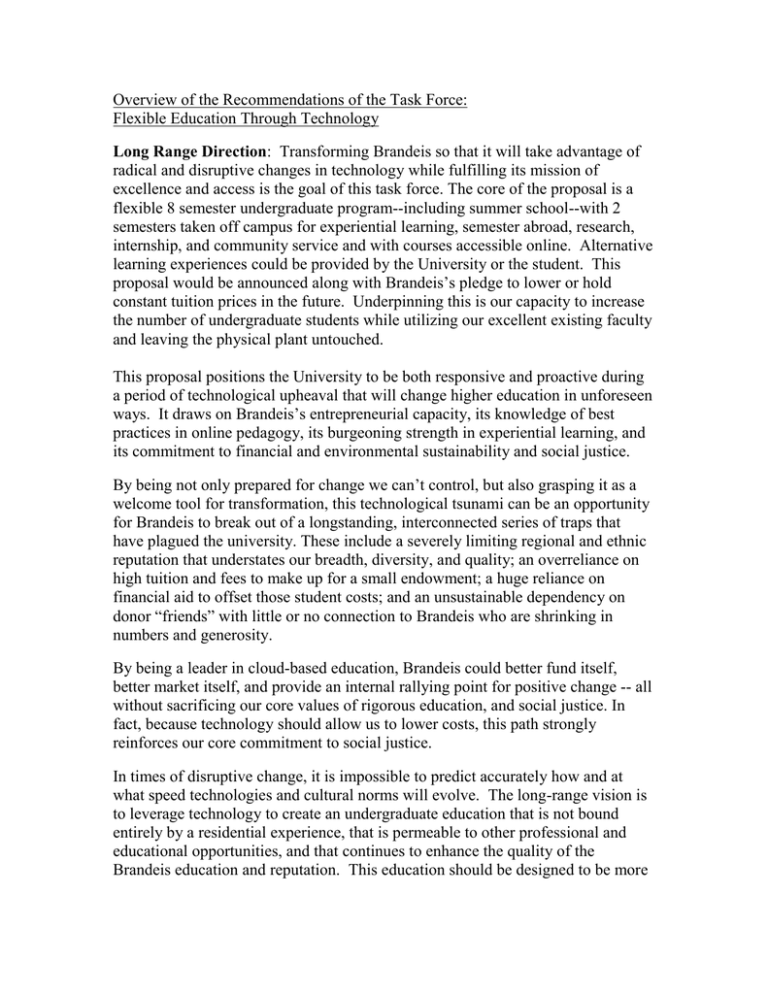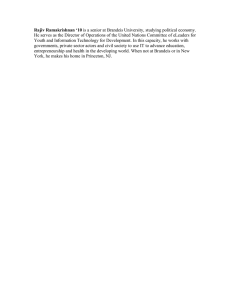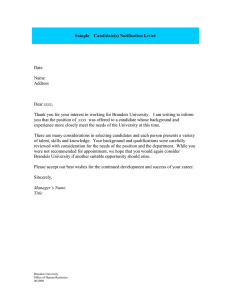Overview of the Recommendations of the Task Force: Long Range Direction
advertisement

Overview of the Recommendations of the Task Force: Flexible Education Through Technology Long Range Direction: Transforming Brandeis so that it will take advantage of radical and disruptive changes in technology while fulfilling its mission of excellence and access is the goal of this task force. The core of the proposal is a flexible 8 semester undergraduate program--including summer school--with 2 semesters taken off campus for experiential learning, semester abroad, research, internship, and community service and with courses accessible online. Alternative learning experiences could be provided by the University or the student. This proposal would be announced along with Brandeis’s pledge to lower or hold constant tuition prices in the future. Underpinning this is our capacity to increase the number of undergraduate students while utilizing our excellent existing faculty and leaving the physical plant untouched. This proposal positions the University to be both responsive and proactive during a period of technological upheaval that will change higher education in unforeseen ways. It draws on Brandeis’s entrepreneurial capacity, its knowledge of best practices in online pedagogy, its burgeoning strength in experiential learning, and its commitment to financial and environmental sustainability and social justice. By being not only prepared for change we can’t control, but also grasping it as a welcome tool for transformation, this technological tsunami can be an opportunity for Brandeis to break out of a longstanding, interconnected series of traps that have plagued the university. These include a severely limiting regional and ethnic reputation that understates our breadth, diversity, and quality; an overreliance on high tuition and fees to make up for a small endowment; a huge reliance on financial aid to offset those student costs; and an unsustainable dependency on donor “friends” with little or no connection to Brandeis who are shrinking in numbers and generosity. By being a leader in cloud-based education, Brandeis could better fund itself, better market itself, and provide an internal rallying point for positive change -- all without sacrificing our core values of rigorous education, and social justice. In fact, because technology should allow us to lower costs, this path strongly reinforces our core commitment to social justice. In times of disruptive change, it is impossible to predict accurately how and at what speed technologies and cultural norms will evolve. The long-range vision is to leverage technology to create an undergraduate education that is not bound entirely by a residential experience, that is permeable to other professional and educational opportunities, and that continues to enhance the quality of the Brandeis education and reputation. This education should be designed to be more affordable, should attract more diverse students, and should offer new learning models to serve alumni. It is crucial, however, that we not lose sight of the ‘small class’ experience, the collaborative learning and dynamic interaction between faculty and students that is a hallmark of a Brandeis education. Great teaching is great learning in that great teaching occurs when the teacher is learning too. In the classroom of the future, whether virtual or actual, faculty should be able to pursue new ideas through scholarship and through testing and developing this thinking with students. This paradigm should be the foundation for our pedagogical and technological experimentation. Strategic Recommendations for Year One In the near and medium term, there are tactical and strategic initiatives that the University should implement to take advantage of opportunities as they emerge. 1. 2. Formulate a business plan to develop this proposal. To achieve this type of transformational change, we will need a new leader with an Office of Educational Innovation that will: • Incentivize innovation and experimentation with technology to optimize teaching and research in the classroom and online, Distribute stipends to innovative faculty and develop revenue-sharing options with both schools and departments, Develop collaborative partnerships within and outside the university and the academy for online and classroom uses of technology in teaching and research, Provide lively, engaged comprehensive support for the implementation of online courses via seed awards, a digital laboratory, and technology-transfer functionality, Act as a lobbyist and a support system for administrative, structural, and intellectual change of both hearts and minds in this broad area of endeavor. • • • • 3. Expand the online learners served through the Rabb School, ranging from high school students and undergraduates, to graduate students, adult learners, and alumni. In so doing, Rabb will become known for online innovation, will become more integrated with the University as a center of expertise in online pedagogy, and will significantly increase its revenue generation. Foundational Tactics Extend library and IT infrastructure and services, commensurate with the demand for new kinds of information services implicit in these recommendations. • • • • • • • • • Raise Brandeis’s profile online by joining or forming one or more institutional consortia to pool online courses and to coordinate experimentation on new ways of teaching. Partner with a community college through an articulation agreement to expand the accessibility and affordability of a Brandeis education by offering Brandeis online courses to community college students as a first step to completing their degree at Brandeis. Enhance GAP year and BA/MA programs with online courses that improve learning, collapse overall program time, and facilitate internships and professional experiences to improve students’ readiness for and abilities to secure employment. Develop a ‘parallel-skype’ tele-presence model, enabling high-school students, adult learners, and alumni who are not resident to participate in some classes in real-time. Expand online courses offered through Rabb during summer school. This initiative could be a laboratory for innovation for the University. Expand online degrees offered through Rabb and explore possible joint degrees with A&S and Graduate Professional Studies. Recommendations for the next 3 - 5 Years An online Summer School. Robust online learning communities for alumni and friends. A matrix of collaboration among faculty, the Office of the Provost, the Office of Educational Innovation, and Library and Technology Services, with an emphasis on pedagogical research and evaluation, on the one hand, and superior service to students on-campus and online, on the other. Rationale: All of these recommendations build on existing strengths. The flexible undergraduate education offers an opportunity to make the residential experience more intense, focused, and transformative while reducing problems with over-crowding and even deferred maintenance--if a building or two could be eliminated. The time off campus encourages students to explore and learn in other venues, while remaining connected to Brandeis, whether before coming to Brandeis (gap year) during their years at Brandeis, or earning a master’s while being employed. In addition, the time off-campus should cost students less and augment their foundation for employment. The new Director of Educational Innovation, and enhanced library and technology services, will support faculty experimentation with new information practices in a way that benefits their teaching and research and perhaps leads to new discoveries. Online courses afford faculty the flexibility to work remotely, and new sources of revenue provide the incentive to invest and innovate in online courseware, while furthering research and collaboration with colleagues around the world. Consolidating what is happening now in several venues and designating the Rabb School as the nexus for learning at multiple points in a student’s career will increase long-term alumni engagement and satisfaction. In order to succeed in all of this, Brandeis will need to be able to provide superior student services, superior research support, and superior flexibility in administrative systems, by comparison to our peers and competitors. Brandeis’s Values and Commitments: The time off-campus encourages undergraduate research, as well as the application of liberal arts skills; it could also be an opportunity for students to help repair the world. The new Office of Educational Innovation would support faculty research collaborations with colleagues at other institutions and provide funds for improving teaching. Partnering with community colleges will increase the racial and economic diversity of the student body. Rabb already provides access to non-traditional students; this expands its outreach and could increase intergenerational learning by linking undergraduates to adult learners, whether graduate professionals or retired learners. As a research university with expert faculty in the cognitive and social sciences, the humanities, computer and information science, and other relevant areas, Brandeis should address new ways of teaching and learning as a research problem—by gathering data, experimenting, reflecting, critiquing, and innovating. An interesting local example of externally funded research in online and on-campus education can be found at http://www.simmons.edu/gslis/academics/courses/online/269.php Financial Resources: The flexible education concept will require some initial investment to increase experiential, research and service opportunities, but should generate revenue by increasing the number of students served. The Office of Educational Innovation is an investment in the future. Without it, our faculty will not be able to ‘surf the disruption.’ The expansion of Rabb will generate revenue via tuition, but will incur costs for marketing, supporting faculty online experiments and alumni programs. Year One Recommendation: To create an Office of Educational Innovation and a Director of Educational Innovation to take charge of it. The object will be to meet the challenge of the disruptive, transformational change that is taking place in the application of information technology to higher education, and to do so with wisdom, creativity, and courage in a way that sustains the goals and strengths of Brandeis. Rationale: Higher education is being, has been, and will continue to be transformed in fundamental ways by unprecedented access to knowledge of all kinds, by new technological vehicles for communication and for the creation of synergistic communities, and by the creative application of technology to develop and convey new knowledge. It is impossible to predict what will happen in an era of vital and rapid change, but the university must respond boldly and effectively to the challenge and opportunity that such change represents. Doing so will require intelligent, well-funded leadership that knows how to encourage and manage change, since intellectuals have been learning how to resist and also adopt technological change since Plato inveighed against the deleterious effects of writing upon a culture of the spoken, performed, and remembered word — even as he himself wrote dialogues. In this new, networked, globalized, democratized world of higher education, Brandeis can capitalize on the fact that it is a small, private research university by pioneering the development of thoughtful, nimble uses of information technology in the service of its educational and ethical goals. Brandeis’s Values and Commitments: A networked, globalized, democratized world of higher education is ipso facto a vehicle for the Brandeis tradition of social justice: the economic and political barriers to learning are falling as we speak. In the 21st Century, education is a human right, learning is by definition lifelong, and our survival depends on the way that we foster intelligence in ourselves and all others. If we believe those things, we should do what we can to ensure that we reward ability with opportunity, wherever we find it, and that we exploit every tool and strategy to increase access to wisdom and its inculcation. Financial Resources: The Office of Educational Innovation would require substantial funding, on the order of one million dollars per year eventually. It could begin with $250,000 and then scale up. One of its goals should be to generate grant funding of equal value to its annual expenditures within five years; if it does not reach that goal, annual funding should be reduced to the actual level of return, unless there are compelling reasons to do otherwise. The Director of Educational Innovation should report directly to the Provost, and should have expertise in pedagogy, digital culture, information science, or another relevant discipline. All support for faculty projects should be awarded on the basis of a transparent peer review process that includes external reviewers, and all funded projects should report their successes and failures to the campus by easily accessible and regularly scheduled report and assessment. There should also be a defined path to migrate successful innovative projects to production levels, so that the resources for experimentation are not drained for maintenance. The office should have a staff of three to five people with skills in the following areas: emerging technologies; emerging pedagogies; instructional technology design; assessment of learning; computer programming; project management; ethnography; data curation; sociotechnical systems; and grant writing. Last but not least: the Office of Educational Innovation should be located in the library, since libraries are historically the center for innovation in teaching and research. To speak only of the recent past, libraries have invented new uses of information technology for open access, preservation of the cultural record, curation of scientific data, support for online learning systems, and collaboration in research. The key concept for the success of this new Office of Educational Innovation is the idea of collaboration, of partnership with all constituencies in the university, all of which are faced with adapting to change, and the library is also a common ground for all of them. __________________________________________________________________ Year One Recommendation: Establish the Brandeis Summer School as a laboratory for innovation for Arts and Sciences faculty with a three-year goal (2014) to put a substantial number of summer school courses online and a longer timeline to have a fully online summer semester. Rationale: Offering online courses in the Summer School can provide an opportunity for Brandeis faculty to explore online teaching, enlarging and supporting their thinking about online education in general. Developing flexible approaches to offering courses will enlarge opportunities for Brandeis students who wish to live at home in the summer or to maintain a job or undertake an internship, service learning, travel or engage in other activities away from Waltham while studying. External students will consider courses from Brandeis and be able to register from wherever they are. The Brandeis institutional profile will be more visible as a larger external pool of students, including secondary school students attracted for one or more summer programs, and faculty learn about excellent, unique online courses at Brandeis. Additional registration generated by courses available at distance will augment the revenue stream to the University. Brandeis’s Values and Commitments: Summer offerings online potentially will reach new student demographics, allowing a broader cross-section of students access to the depth and wealth of Brandeis liberal arts courses and faculty. Financial Resources: Necessary university investments would include course designers, compensation for subject matter experts, faculty development and preparation for on line teaching, appropriate marketing for a national online audience, and academic support for students. While no explicit content area has yet been chosen, the approval route for on line courses has been identified with the Dean of Arts and Sciences, making summer 2014 a possible initiation term. Year One Recommendation: Grow the Rabb School, particularly the Division of Graduate Professional Studies (GPS), and create online offerings for high school students, undergraduates, adult learners and alumni, to benefit the University. Rationale: In the short-term, focus on GPS, a revenue-generating unit serving professional adult students. Degree programs are almost exclusively offered on line. At the same time, pilot online options for high-school students and adult learners. • • • • • • • • • • Revenues generated by GPS can be enhanced if we: Develop one or more new master’s degree programs in professional fields, possibly by partnering with other local institutions. Apply market research and more in-depth analysis to our current and potential student populations to develop more effective marketing programs. Build additional partnerships with corporations that employ (and support) GPS students. Explore the international market, particularly via international corporate contacts. Partner with other units in the University to produce entirely new jointlysponsored programs on line. Develop outreach to and clear paths for transitional admission to GPS for Brandeis graduating seniors—as one approach to a BA/MA with master’s courses online. Utilize existing corporate contacts (Trustees, alumni, current students, instructors, professional advisors) more effectively. Re-develop the Rabb GPS website to present a more up to date and dynamic face to the market. Explore the possibility of a second partnership with a market research/marketing/recruitment organization, focused on developing a particular program. (AND/OR) Develop an in-house capability to provide more high-powered marketing, reaching further into the national market than we have done on our own to date. Brandeis’s Values and Commitments: Enlarging the GPS student “draw” will extend access to the opportunities offered at Brandeis to a larger, more diverse pool of adult professional students. Cooperation with other units in the University will broaden the online offerings of the Rabb School and the University and draw attention to Brandeis’s strengths and uniqueness. Financial Resources: A new program will require specific marketing and outreach upon launch. On-campus collaborative efforts will require a negotiated revenue sharing process and the development of supportive infrastructures as needed. An external partnership with a recruiting entity will generate strong return to the University but require a substantial revenue share arrangement as well. When GPS does indeed grow in registration, additional marketing, advising and admissions support will be required. The professional redevelopment of the website will require a budget expenditure. __________________________________________________________________ Foundational Tactic: Brandeis University should raise its profile online in a variety of ways: by joining consortia as a means of experimentation, and joining iTunes University as an institution, taking its place among many like institutions. Several elite consortia are emerging, and Brandeis should be selective. For example, the membership of iTunes University includes many peer institutions whose programs, opportunities and unique offerings are clearly highlighted in their sites. Edx, Coursera, and other emerging university consortia should be investigated and evaluated for fit with Brandeis’s strategic goals. Various Boston-area consortia in which Brandeis already participates also offer opportunities for strategic alliances, and there may be commercial vendors who would be effective partners in some Brandeis endeavors and experiments. Rationale: This is a tactic that is overdue. Consortial discussions are beginning now, while research consortia in certain fields are already underway. Brandeis would join with sister institutions of like quality in exploring distance learning. Joining one or more consortia will allow Brandeis to “try on” distance learning by providing an environment in which a few courses can initially be developed and tested. Also, courses from partners would likely be available to Brandeis students. Overall the Brandeis curriculum would be enhanced by courses in topics and fields not offered here but available online through the consortium. Adventuresome departments and instructors will be empowered to lead the way, receiving support in the development and offering of courses. Collaborations in teaching and learning can/will develop among consortium members, as mutual confidence and respect grow with greater exposure. An easy and obvious first step is joining iTunes University, which would at least include Brandeis in the large number of American universities that make all sorts of information available to the public (examples are lectures at special events, outlines, samples or recordings of whole or partial courses, student work, promotional material about the university or parts of it, all sorts of recordings and video.) Audiences on iTunes University may also be restricted, allowing an individual instructor to post something for his/her own students, or for some other selected group. By not being present in iTunes University, Brandeis misses an opportunity for public outreach and for supporting learning. Brandeis’s Values and Commitments: Presence in consortia and iTunes University will make information about Brandeis University available to a huge population of inquiring people, possibly attracting and giving access to a traditional or adult student demographic otherwise unaware of Brandeis. Financial Resources: Investment from the university in consortia includes administrative leadership, faculty time for course development and teaching, instructional designers to support faculty, and provision of staff for student monitoring/advising and support. Initial participation in iTunes University requires an agreement (contract) but no apparent fee (visible in the website, at least.) A requirement is that the university provides a site manager who regularly edits, produces, and maintains the Brandeis site. _______________________________________________________________ Foundational Tactic: Partner with a community college to expand the accessibility and affordability of a Brandeis education by offering Brandeis online courses to community college students as a first step towards their completing a degree at Brandeis. Students could complete requirements, try new disciplines, and gain needed preparation before arriving on campus. The flexibility offered by these online courses could allow them to work even after they’ve arrived at Brandeis. Rationale: Brandeis should have an articulation agreement with a community college that provides a clear path for students who may not otherwise have access to a liberal arts education. Online courses could be sequenced to build students’ capacity and could provide a less expensive option for students who can’t afford to live on campus and may need to work longer hours. Brandeis’s Values and Commitments: This is in keeping with the Brandeis tradition of access and would increase the diversity of students. Financial Resources: Ideally, these courses would have already been developed as a result of consortia or in venues such as summer school. Some administrative coordination and admissions time would be needed. Greater long-term financial aid is also implicit in the commitment to support these students so that they graduate successfully and without oppressive debt. __________________________________________________________________ Foundational Tactic: Offer more BA/MA programs with online master’s courses that provide credentialing for less tuition, reduce overall program time, and facilitate internships and professional experiences to improve students’ readiness to address real-world problems and their ability to secure employment. Rationale: Building on existing 5-year BA/MA programs, think about new areas for combined degrees, and move as many master’s courses online as possible to give students maximum flexibility and an additional credential increasingly demanded by the marketplace. Brandeis’s Values and Commitments: Ideally, this would encourage more experiential learning opportunities and internships, so that students can combine theory with practice. Financial Resources: Faculty stipends for course development, as well as instructional design support. __________________________________________________________________ Foundational Tactic: Develop a “Parallel Skype” tele-presence model, enabling students who are not resident to participate in classes in real time. Today, we might do this with an array of tablets along the back wall of certain classrooms enabling students to “Skype in” to attend classes. This could open Brandeis classes to many different audiences, from high-school students visiting campus virtually, to adult learners from BOLLI, to foreign students paying partial tuition to attend every lecture/discussion of a course. Rationale: The single largest revenue opportunity in this period of technological change in higher education is the emerging middle class of the developing world, who will be students from outside the northeast of the US. How can we provide a Brandeis education, at some level, to these students? The answer is Tele-presence. Formerly this was expensive. Now it is free. As a test, we can wire in 25 tablets to the back of a classroom and use parallel Skype to “fly in” learners across the age spectrum. First, we can use this to attract highschool students from beyond the northeast region, inviting them to visit our classes, thereby expanding our high-school recruitment. Next, we can offer adult learners access to our core classes, instead of just special seminars. Thirdly, we can use it to strengthen student-teacher interactions with universities we have relationships with such as Olin and Columbia. In the long term, if the technology works, we might open Brandeis University Remote Dormitories (BURD’s) around the world through property rentals of hotels to offer complete Brandeis degrees at say a 75% tuition rate. The dorms would supply rooms and food concessions, classrooms, and gyms, and produce Brandeis degrees without increasing the load on our own dorms and food services. Parents looking for an elite branded education, yet with the ability to visit their children on weekends, would flock to such an offering. Brandeis’s Values and Commitments: The Tele-presence model supports diversity of age, geography and national origin. We note that Brandeis has a new value of globalism, which would be improved by our long-term vision. Financial Resources: The investment in tablets and customized software is quite low. As we prove out the technology and manage its cost, we could successfully test the program and start to take overseas students in a manner in which the revenue generated would be significant, while costs increases would be low. However, the cost of teaching in a new way and researching learning outcomes in a new pedagogical model would need to be addressed. __________________________________________________________________ Task Force Members Vice Provosts: Michaele Whelan, John Unsworth Trustees: Stuart Lewtan ’84, Walt Mossberg ‘69 Faculty: Jordan Pollack (Computer Science) Billy Flesch (English) Lenny Muellner (Classics) Grace Zimmerman (IBS) Staff: Sybil Smith (Graduate Professional Studies, Rabb) Marci Borenstein (High School Programs) David Wedaman (LTS) Students: Jay Dev Todd Kirkland




